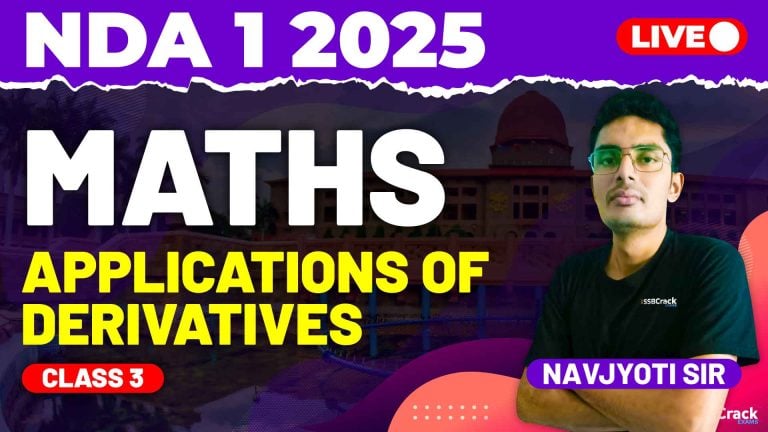Preparing for the NDA-NA Exam, particularly Paper I in Mathematics, requires a thorough understanding of various topics, including probability. This recent class dedicated to probability aimed to provide students with the skills necessary to solve related MCQs effectively. This article will highlight the key points discussed in the class and offer strategies to approach probability in the exam.
Understanding Probability
Probability is the branch of mathematics that deals with the likelihood of events occurring. It forms the foundation for statistics and various applications in science, engineering, economics, and more. Mastering probability is essential for scoring well in the Mathematics section of the NDA-NA Exam.
Key Concepts Discussed
- Random Experiment:
- A random experiment is an action or process that leads to one or more outcomes, where the outcome cannot be predicted with certainty. Examples include tossing a coin, rolling a die, or drawing a card from a deck.
- Sample Space:
- The sample space is the set of all possible outcomes of a random experiment. For example, the sample space for rolling a die is {1, 2, 3, 4, 5, 6}.
- Probability:
- Probability is a measure of the likelihood of an event occurring, ranging from 0 (impossible event) to 1 (certain event). It is calculated as the ratio of the number of favorable outcomes to the total number of possible outcomes.
- Equally Likely Events:
- Events are equally likely if each event has the same chance of occurring. For example, each face of a fair die has an equal probability of 1/6.
- Exclusive and Exhaustive Events:
- Events are mutually exclusive if they cannot occur simultaneously. For example, when flipping a coin, the events “heads” and “tails” are mutually exclusive.
- Events are exhaustive if they cover the entire sample space. For example, in a die roll, the events {1, 2, 3, 4, 5, 6} are exhaustive.
- Conditional Probability:
- Conditional probability is the probability of an event occurring given that another event has already occurred. It is denoted as P(A|B), the probability of A occurring given B has occurred.
- Bayes’ Theorem:
- Bayes’ Theorem provides a way to update the probability of an event based on new evidence. It relates the conditional and marginal probabilities of random events and is particularly useful in various fields such as medicine, finance, and machine learning.
Strategies for Solving Probability MCQs
- Understand the Problem:
- Carefully read the problem statement to identify the random experiment, sample space, and events involved. Ensure you understand what is being asked before attempting to solve the problem.
- Identify Key Elements:
- Determine the type of events (equally likely, mutually exclusive, exhaustive) and the relationships between them (independence, dependence).
- Use Probability Rules:
- Apply basic probability rules and theorems (such as addition and multiplication rules) to find the required probabilities. Ensure you are familiar with the concepts of conditional probability and Bayes’ Theorem.
- Break Down Complex Problems:
- For complex problems, break them down into simpler parts. Solve each part step-by-step, using appropriate methods and probability rules.
- Practice Regularly:
- Practice a variety of MCQs on probability to become comfortable with different types of problems. Regular practice will help you recognize patterns and apply concepts more quickly and accurately.
Effective Preparation Strategies
- Solidify the Basics:
- Ensure you have a strong understanding of basic probability concepts, as these form the foundation for more complex topics. Review definitions, rules, and theorems regularly.
- Solve a Variety of Problems:
- Work on different types of problems to gain a broad understanding of probability. Practice problems involving random experiments, sample spaces, mutually exclusive and exhaustive events, and conditional probability.
- Understand Applications:
- Study how probability is used in real-world scenarios. Understanding applications can make abstract concepts more tangible and easier to grasp.
- Review and Clarify Doubts:
- Regularly review your work and clarify any doubts with teachers or peers. Discussing problems with others can provide new insights and reinforce your understanding.
- Take Mock Tests:
- Take regular mock tests to assess your preparation level and identify areas for improvement. Timed tests will help you manage your time effectively during the actual exam.
- Stay Updated with Exam Patterns:
- Stay informed about the exam pattern and types of questions typically asked in the NDA-NA exam. Familiarize yourself with the format and structure to reduce surprises on exam day.
Conclusion
Mastering probability is crucial for performing well in the NDA-NA Mathematics exam. By understanding key concepts, practicing regularly, and applying effective strategies, you can improve your problem-solving skills and increase your confidence. Remember to approach your preparation with dedication and a positive mindset. Consistent effort and thorough understanding of the material will lead to success in the probability section of the exam.
Approach your preparation with a positive mindset and use the strategies discussed here to excel in your NDA-NA exam. Good luck!


















